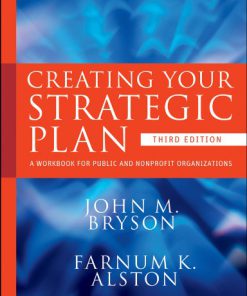Human Resources Management for Public and Nonprofit Organizations: A Strategic Approach
$50.00 Original price was: $50.00.$25.00Current price is: $25.00.
Human Resources Management for Public and Nonprofit Organizations: A Strategic Approach – Digital Instant Dowload.
Human Resources Management for Public and Nonprofit Organizations: A Strategic Approach – Digital Instant Dowload.

Product details:
- ISBN-10 : 9781118398623
- ISBN-13 : 978-1118398623
- Author: Joan E. Pynes (Author)
Since the first edition was published in 1997, Human Resources Management for Public and Nonprofit Organizations has become the go-to reference for public and nonprofit human resources professionals. Now in its fourth edition, the text has been significantly revised and updated to include information that reflects changes in the field due to the economic crisis, changes in federal employment laws, how shifting demographics affect human resources management, the increased use of technology in human resources management practices, how social media has become embedded in the workplace, and new approaches to HRM policy and practice.
Table contents:
PART ONE: HUMAN RESOURCES MANAGEMENT IN CONTEXT 1
1 Introduction to Human Resources Management in the Public and Nonprofit Sectors 3
The Public Sector 5
The Nonprofit Sector 10
The New Public Service 22
Today’s Context for Human Resources Management 23
Conclusion 33
2 Strategic Human Resources Management and Planning 37
The Changing Role of Human Resources Management 38
Human Resources Outsourcing 42
Strategic Human Resources Management and Human Resources Planning 44
Human Resources Planning 45
Human Resources Information Systems and Electronic Human Resources
Management 50
Implementing Strategic Human Resources Management 57
Evaluating the Effectiveness of Strategic Human Resources Management 58
Problems and Implications of Strategic Human Resources Management 60
Ethical Standards for Strategic Human Resources Management 61
Conclusion 62
3 Federal Equal Employment Opportunity Laws and Other Employee Protections 69
Federal Equal Employment Opportunity Laws 70
Proving Employment Discrimination 82
Executive Orders, Affirmative Action, and Other Federal Laws 88
Affirmative Action 93
Constitutional Rights 97
Additional Protections for Employees 103
Conclusion 105
4 Managing a Diverse Workforce 111
Glass Ceilings, Sticky Floors, Glass Walls, and Glass Escalators 114
Why Diversity Is Important 115
Cultural Competency 116
Sexual Harassment 119
Employer Liability 121
Sexual Orientation 122
Changes in the Nonprofit Landscape 125
The Difference between Complying with Laws and Managing Diversity 126
Strategic Human Resources Management Implications for
Managing Diversity 128
Conclusion 130
PART TWO: METHODS AND FUNCTIONS OF STRATEGIC HUMAN RESOURCES MANAGEMENT 137
5 Job Analysis 141
Legal Significance of Job Analysis Data 143
Job Analysis Information and Methods 144
Designing a Job Analysis Program 151
Job Description and Job Specification 153
Strategic Job Analysis 153
Competency Modeling 159
Job Analysis Techniques 160
Contextual Performance 167
Conclusion 168
6 Recruitment and Selection 175
Recruitment 176
Recruiting for Local Governments and Nonprofits 181
Screening Applicants 184
Executive and Managerial Recruitment and Selection 202
Conclusion 204
7 Compensation 211
Equity 212
Executive Compensation and Benefits 229
Federal Laws Governing Compensation 231
State and Local Government Minimum Wages 234
Conclusion 240
8 Benefits 247
Required Benefits 248
Discretionary Benefits 253
Quality-of Work and Quality-of Life Issues 260
Conclusion 270
9 Training and Career Development 275
The Training Process 278
Career Development 293
Managerial and Executive Development 294
Conclusion 296
10 Performance Management 303
Motivation 306
Developing an Evaluation Program 311
Rater Training 312
Who Should Rate? 315
Executive Evaluation 316
Documentation 319
Performance Evaluation Interview 320
Ethical Issues in Performance Appraisal 321
Performance Appraisal Techniques 322
Team-Based Performance Techniques 329
Conclusion 333
11 Labor-Management Relations: Collective Bargaining in the Public and Nonprofit Sectors 341
The History of Private Sector Collective Bargaining 342
Collective Bargaining in Nonprofit Organizations 345
Collective Bargaining in the Federal Government 346
Collective Bargaining in State and Local Governments 347
Concepts and Practices of Collective Bargaining 348
Public Sector Distinctions 359
Nonprofit Sector Distinctions 363
Privatization of Public Services 366
Conclusion 367
12 Volunteers 377
Use of Volunteers 378
Volunteer Motivation 381
Barriers to Volunteer Recruitment 381
Recruitment 382
The Prerecruitment Process 384
Managing Volunteers 389
Orientation and Training 391
Volunteer Recognition 392
Evaluation 393
The Volunteer Protection Act 394
Governing Boards 394
Conclusion 402
13 Conclusion: Challenges for Public and Nonprofit Organizations 409
What to Expect 409
Challenges for Strategic Human Resources Management 412
Change in Skill Requirements 413
You may also like…
Business & Economics - Management & Leadership
Uncategorized
Managing Human Behavior in Public and Nonprofit Organizations 5th Edition, (Ebook PDF)
Business & Economics
Strategic Leadership and Management in Nonprofit Organizations: Theory and Practice 2nd Edition












